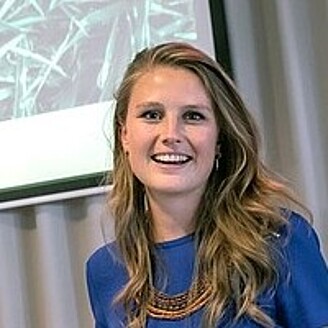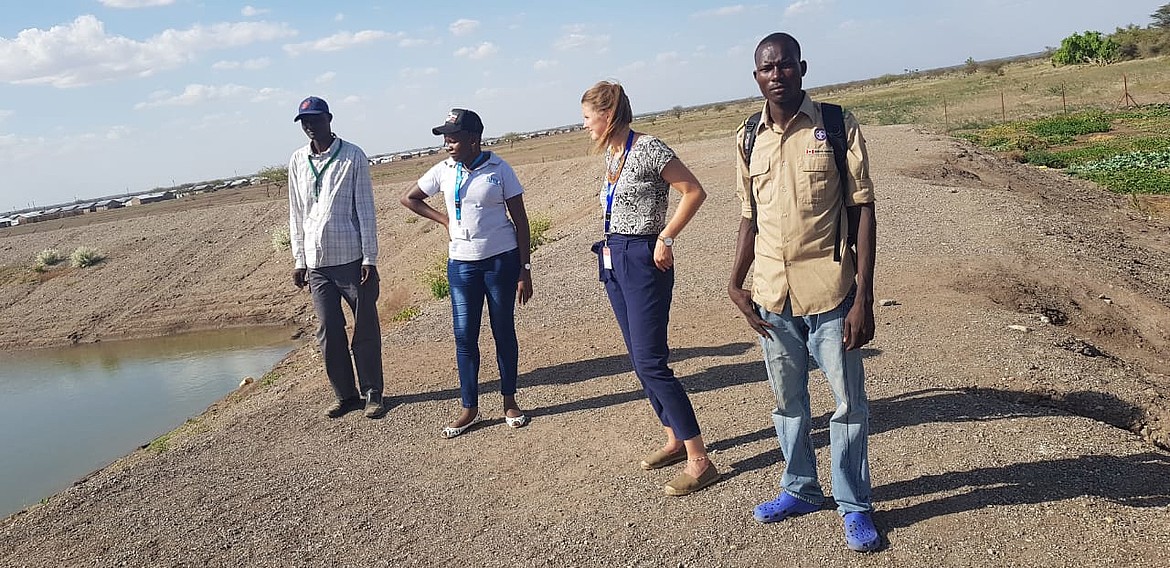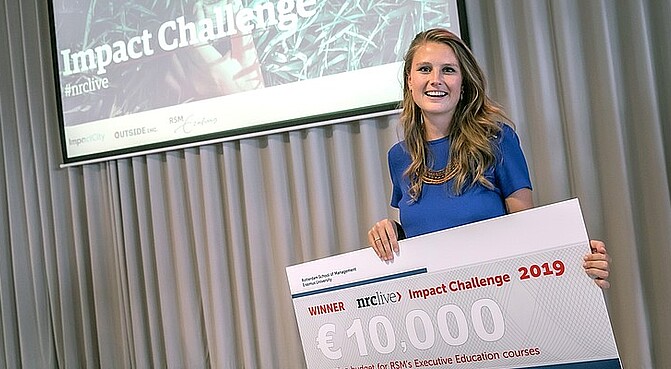I really enjoy the challenge of turning this idea into a sustainable business. [. . .] I believe in solutions that are prolonged, that enable refugees to secure their own livelihoods, to start building a proper life.
Lonneke Noteboom

Last year, Lonneke Noteboom, at the time Senior Sustainable Finance Associate at Dutch development bank FMO, won the NRC Live Impact Challenge. It was a 100-day challenge for 100 change makers who followed an online course on intrapreneurship, best practices and ways to implement their plan to bring about change within their organisations. Her idea? An Agroforestry project to empower refugees in Kakuma, Kenya, at the same time as serving the needs of the local community and thereby stimulating the economy. She proposed using agroforestry to address environmental as well as social needs. Almost one year on, we talked over Zoom about the progress of her project.
How did you come up with your idea?
Refugee crises have always had a special place in my heart. By the time I was participating in the Impact Challenge, I had already visited the refugee camps in Lesbos three times. The first time came about because of a shared frustration with my younger sister. We both read and heard so much about what was happening in the refugee camps and we were tired of not being able to do anything to help the disaster that was happening. We decided to go volunteer and the trip had so much impact that I ended up going back twice, bringing along a group of colleagues with me each time. Throughout those three visits, I felt this sense of urgency; a drive to try and bring some humanity to the camps. This feeling has never faded.
“When the Challenge started, thinking of a way to help a refugee camp was therefore very logical to me. Because I was going to work in Kenya for six months immediately after the Challenge, this was already planned, I chose to focus on Kenyan refugee camps to increase the chance of successful implementation.
“My project was great on paper. When I finished the Impact Challenge, I even thought to myself ‘why hasn’t this been done before?’”
"How do we plant productive trees on land that is dry, where there is little rainfall?"
Kenya
Once in Kenya, Lonneke worked on the Agroforestry project alongside her job at FMO.
“I spoke to several local organisations to find support and find out who would be interested in joining the project. Through a local NGO, I was able to visit the Kakuma refugee camp. We conducted quite a bit of research with several organisations that were already there, such as the UN Refugee Agency, the UN Food and Agriculture Organisation, the World Food Programme, and a few other NGOs.
The idea is to plant ‘productive trees’. This means that the trees are not only planted for the environment, to soak up carbon emissions, but that they also contribute to the economy by way of the harvest that they produce.
“My initial idea was to plant mango trees because the produce can be used to stimulate the economy. However, it can take three or more years for mangos to fruit, so it would be a long time before they yield any profit. After speaking to some organisations, grass was also considered a good option because the local area has a lot of pastoralists with cattle to eat the grass. This, in turn, could set up local trade. I started thinking about interesting combinations of crops, which is actually the crux of Agroforestry. You do not just grow mangos but intercrop with grass, ginger, chili and beehives for example. The different crops have a positive effect on each other, and allow communities to harvest multiple times a year.
“Factors we looked into include whether there is land to plant these trees and whether it would be possible for refugees to work alongside the locals. In fact, this was a key component of the project; stimulating positive interaction between refugee – and host communities.
“Something I tried to remember was to stay away from the white saviour complex, Eurocentrism, or looking only from the Western perspective, but instead to think locally. I tried to think as much from their perspective as I could, and what is it that they need. How do you make sure that it works in their environment? Is it something that those involved in will believe in? I wanted to make sure we set something up in the local context and therefore took a lot of time to find the right local implementation partner.”
After six months of orientation and laying the groundwork in Kenya, Lonneke has returned to the Netherlands, but the project continues.
“I am currently working on getting the business model right. And I’m no longer working alone! There is a seasoned entrepreneur by my side and we jointly investigate the most feasible model to make this work. Can we, for example, sell the fruits and spices on regional and international markets? We also looked into ways to solve the issue of water up in Kakuma.
How do we plant productive trees on land that is dry, where there is little rainfall? For this, we’ve been introduced to the concept of biodegradable cocoons, which is a sort of small bag containing 25 litres of water surrounding the tree seedling. This water gets released gradually throughout an entire year, and it has been found that this is enough water for it to bud and then to grow into a tree. My hope is that we can start planting the trees in the beginning of next year, right in time for the local rain season to give the seedlings the best start possible!”
"I really enjoy the challenge of turning this idea into a sustainable business. [. . .]
I believe in solutions that are prolonged, that enable refugees to secure their own livelihoods,
to start building a proper life."
How has the NRC Live Impact Challenge helped you?
“After I had my plan and had begun working on it, the coaching that I received as part of my prize was really helpful. I was able to get continuous advice from Outside Inc., particularly on whether I had a feasible business model.
“For me it has been such an interesting journey. The challenge started with a small idea on paper, which then turned into the winning pitch in the finals. From that moment onwards, I dove into the deep and undertook each step – from going to Kenya, to visiting the camps, to finding partners and the right business model – as they came. New things keep coming up and that’s what keeps me going too.
“I really enjoy the challenge of turning this idea into a sustainable business. There are lots of short-term projects going on in refugee environments, which are very necessary. At the same time, I believe in other ways to make a difference. Solutions that are prolonged, that enable refugees to secure their own livelihoods, to start building a proper life. The challenge only confirmed and solidified this for me.”
Do you have any words of advice for those who want to do something similar or are starting with an idea?
“Find something you already feel a lot of passion for. Once you’ve chosen this, what I often do is take a blank piece of paper, and write down the first thing that comes to mind. This can be a drawing of something, a list, or a word. It can literally be anything! Once you’ve got something on paper, you can start to identify what aspect it is that is the most interesting to you. Then you can look at what it is you want to investigate and can even do some simple research into this.
“I’d also advise talking about it a lot. Conversations always lead to new and interesting insights! Plus, talking about it makes it real…
“What is also helpful to remember is to make it small and manageable. Take small steps in order to get to the larger idea you want to implement.”
Looking forward, Lonneke wants to continue her focus on creating sustainable impact, and dedicate time to bringing humanity and dignity back to places and people where living conditions are particularly difficult.

